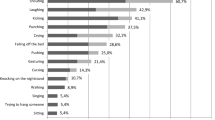Abstract.
We describe the 8-years follow-up of 80 patients affected by idiopathic, L-dopa-responsive Parkinson's disease. All patients were evaluated at baseline and during the follow-up with visual evoked potential, P300 event related potentials and polysomnography. The patients and their relatives compiled sleep and hallucination questionnaires. Statistical analysis was performed to evaluate if visual abnormalities, abnormal P300 recordings or sleep disturbances were linked to the development and hallucinations. Our results show that abnormal vision and abnormal P300 did not correlate with the incidence of hallucinations. However, the presence of REM sleep behavioral disorder (RBD) was significantly related to the development of hallucinations,independently of age, gender or duration of disease but dependent on the amount of dopaminoagonist treatment.
Similar content being viewed by others
Author information
Authors and Affiliations
Additional information
Correspondence to M. Onofrj
Rights and permissions
About this article
Cite this article
Onofrj, M., Thomas, A., D'Andreamatteo, G. et al. Incidence of RBD and hallucination in patients affected by Parkinson's disease: 8-year follow-up. Neurol Sci 23 (Suppl 2), s91–s94 (2002). https://doi.org/10.1007/s100720200085
Issue Date:
DOI: https://doi.org/10.1007/s100720200085




